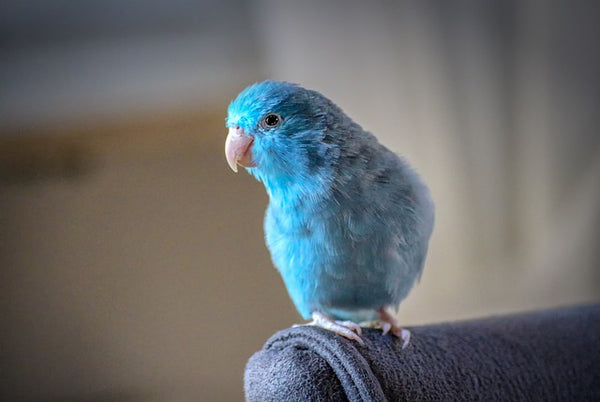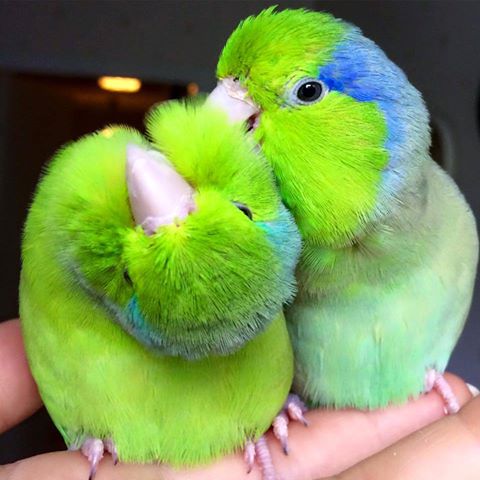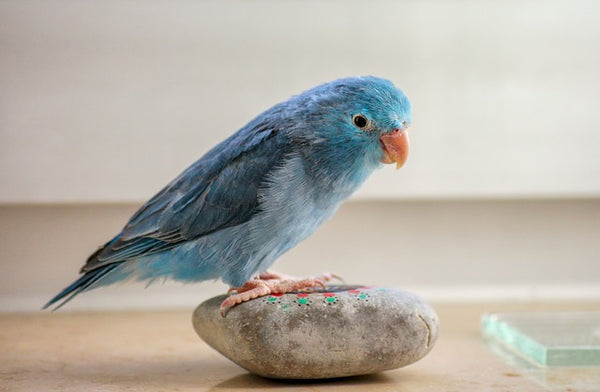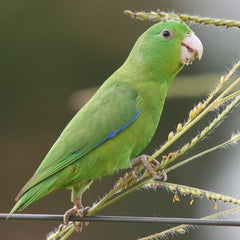Parrotlet Species Care Guide: Pet Bird Size, Diet, Training, Lifespan, Personality & Price
Choosing a pet parrot isn’t as easy as it sounds. There are dozens of different species that can be bought in pet shops today.
The parrotlet stands to the side as one of the smallest species of parrots in the world, and is in fact the smallest parrot available in shops.
This cheerful, but territorial bird is a great housepet, with a wide variety of subspecies and colorful plumages.
Parrotlets’ personality, as being known to be one of the quietest, and their training potential help explain why it’s one of the more popular choices.

Parrotlets Overview
Endemic to South and Central America, this second smallest bird in the parrot family is a popular pet choice. Among the many varieties of parrotlets, the ones best suited for pets are members of the species the Pacific parrotlet (Forpus coelestis) and the green-rumped parrotlet (Forpus passerinus). Other species that can be found in pet stores are usually either the Mexican Parrotlet, the Spectacled Parrotlet, or the Yellow-faced Parrotlet.
This flocking parrot is known for its foraging for seeds, fruits and vegetables in dry wooded areas, and you’ll want to feed your pet with a combination of small seeds such as oats, buckwheat, safflower and hemp in small amounts, sunflower seeds, green leaves and kibble. In captivity, you should feed them with species-appropriate kebbels and small amounts of cut fruit and vegetables.
The highly intelligent parrotlet needs a dynamic environment and lots of exercise, and when tamed they can be very affectionate birds. Parrotlets also display a fearless disposition, so you’ll want to be careful not to tease them, as they can get very defensive of their cages. Because of this, be careful with parrotlets that haven’t gotten used to children, as they can carry a bite!
Characteristics of Parrotlets
Physical
This playful bird is in fact the smallest species of parrots kept as pets. An adult parrotlet can reach the length between 4 and half up to just over 5 inches (approximately 28.5 cm), and a healthy bird will not weight much over an ounce (33 grams). They also have the shortest individual wingspan of 9 and a half inches.
The most popular pet parrotlet species, the Pacific Parrotlet, are distinct because of their bright green feathers. The bulky bird is recognisable for its colorful feathers and a short, tapered tail.
While there are many color mutations of this species of parrots, the males usually carry a dark blue stripe, while the female have darker green feathers with lighter feathers on their wings and backs.
Females can also display a blue or green streak behind the eyes. Of course, blue, yellow, and white parrotlets can be found in the wild and in homes. Interestingly, Green-rumped parrotlets are the only species without blue feathers on their backs.

Behavior
Parrotlets are among the more longer living parrot species, and if their needs are met, parrotlet lifespan can last between 20 to 40 years.
This intelligent and active bird isn’t too loud for keeping in apartments, and while they’re not prodigious speakers, with practice they’re able to learn to speak a couple of words.
It’s said parrotlets are actually full-sized parrots in small bodies. That is, their personalities match their larger cousins. Because of that they need regular exercise and proper training.
Raising One as a Pet - What to Expect
Parrotlet Personality
Parrotlets are active birds with big personalities. They’re also known to be fearless, and as a result, can attack other pets in the household without regards of their size. If you want to avoid the bird developing a loner temperament, you should handle and play with him often.
They can bond and coexist with a single bird, but will in turn be aggressive towards any other birds in the vicinity. Because of their tendencies, be careful in how you let children approach them, they can bite!
On the other hand, if hand-fed they turn into trusting birds that will show affection towards their owner. But be careful, they can also easily ignore you if they bond with another bird. Alone they can get lonely. The best thing you can do is meet the bird’s emotional needs and engage in play and activities with it on a regular basis.
Training
While they come short compared to larger parrots, they can be taught a few tricks too. To make sure your birds potential is met, start training her as soon as possible. Make sure the training is not too strenuous, and the bird feels safe and is relaxed.
With enough instruction, they can learn simple commands and to speak a few words. Males are more inclined to speak—and some parrotlets never learn—regardless of sex.
Here is one parrotlet that loves to chat:
Home Type
The cages should be placed in busier parts of the home, so your parrotlet doesn’t get bored. The interaction with the loud environment will keep him busy and engaged.
Keep in mind they’re not suitable for keeping in the kitchen, as high temperature, smoke and fumes from non-stick pans may harm and even kill them. Also, they need a quiet place for proper rest.
Experience Recommendations
Parrotlets are suited for people without much experience in raising and keeping parrots. The most important thing to remember is to keep them company often to curb their more aggressive tendencies.
Proper Care - Parrotlets as Pets
Cage Size & Setup
In general, the larger the cage the better. It shouldn’t be smaller than 24” W by 24” H by 24” D cage. The most important thing is that the birds have the space to move around and jump in their parrotlet cage. Also, you should consider filling the cage with bird toys so they can keep busy while you’re not with them. Place several perches in the cage, and if you can afford it and have space, use a larger aviary to provide more room.
Apart from the toys, they need three separate containers for dry food, fresh water, and the last for vegetables and fruit. It’s also important that the gaps on the cage are small enough to prevent your parrotlet from escaping, and half an inch should be enough to prevent that.

Parrotlet Diet
Parrotlets should be fed using pellet based bird mix, preferably of high-quality. Your parrotlet will be kept in the best shape if you can enrich their diet with fresh fruit and vegetables on a daily basis.
Parrotlets can eat suitably cut up pieces of peas, broccoli or carrots. They’re also able to eat cucumbers, peeled kiwi, lettuce and zucchini. You can even safely supplement them with apples, bananas, peaches, berries and grapes.
Avoid feeding them vegetables with Oxalic acid like avocados and onions, and spinach. Also avoid grapefruit and tomatoes.
Breeding
It’s important that two birds set apart for breeding should be a true pair of their given species, as only their offspring will be able to reproduce down the line. As for the breeding season, there isn’t one defined for parrotlets, as they can reproduce indoors at any time.
Exercise
Parrotlets need to be active and regularly exercise. Your parrotlet will benefit the most if you pair exercise with social interaction.
They’ll need at least 3 to 4 hours of daily care if you want to keep them healthy and happy. While you can’t completely replicate the conditions in the wild, you can keep your parrotlet busy with different toys designed just for that.
Parrotlet Prices
 Even so, there are subspecies that are more expensive, like the Pacific Parrotlet that can be bought for up to $500.
Even so, there are subspecies that are more expensive, like the Pacific Parrotlet that can be bought for up to $500.
Parrotlets are a relatively affordable species of parrots suited for beginners and people who don’t want to invest much money to start caring for a parrot. On average, a parrotlet can cost between $150 up to $350.
Health
This active and curious bird is known to get in all kinds of mish-mash, so be careful they don’t end up injured while playing. To keep your parrotlet healthy ensure a balanced diet, regularly trimmed feathers, clipped nails, and trimmed beaks so they don't become overgrown.
It’s also important they can bathe every day, but be careful the bird doesn’t drown. Bathing will curb dander, and moisturize the feathers.
Of course, for any concerns please contact your avian vet as they’ll be able to give your pet the best possible care and treatment.
Similar Species
The most similar pet often compared to parrotlets is the lovebird.
At first glance, they look very similar, but these birds native to Africa are larger and heavier than parrotlets, without the sexual dimorphism common in parrotlets.
Summary - Should I Get One?
Parrotlets are active and inquisitive birds suited for new owners that can set apart a few hours every day to play and get to know their bird.
While not the most sociable, and even aggressive towards other birds, if hand-fed and treated right this parrot will show affection and care to their owners.
This second smallest (the smallest kept as a pet) and relatively affordable bird can reward your attention with a few words and tricks it can learn with enough training and care.

Can anyone help l have two parrotlets , supposedly two brothers, there about 5 yrs now, last few weeks been making a nest now 3 eggs layed, help
Which ard the sweetest and cuddly between the Parrotlet and a Lovebird?